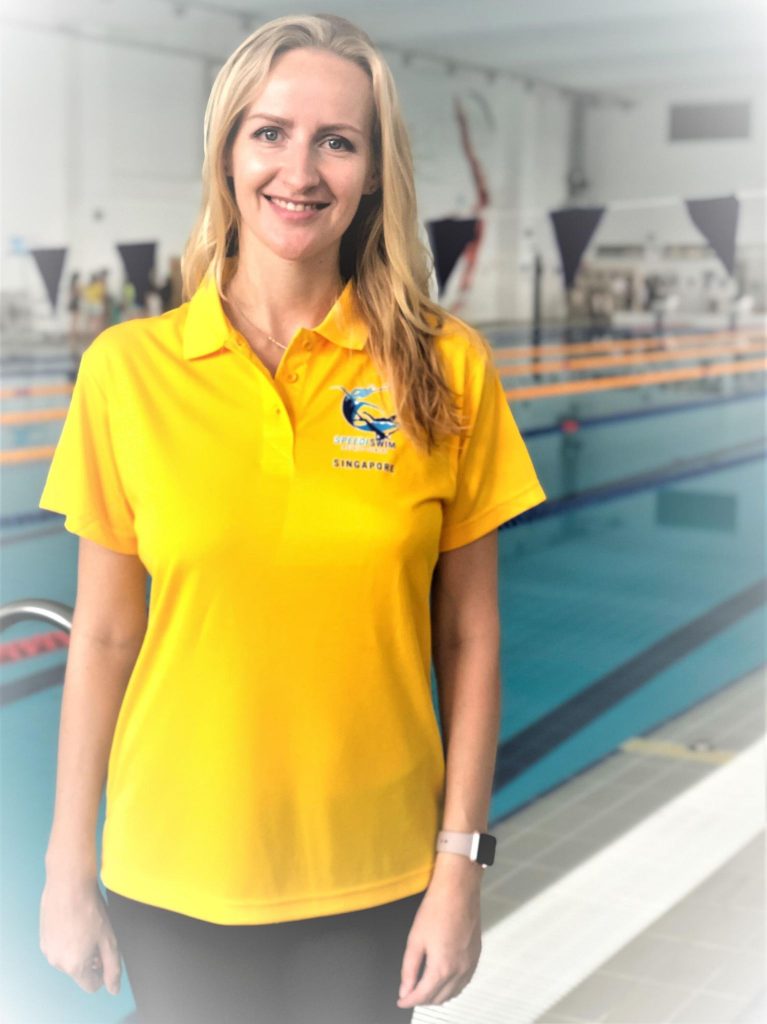
Presenting Speedi Coach: Katsiaryna Kulpo
HEAD COACH, SPEEDI ARTISTIC SWIMMING
Hi, my name is Coach Katya and I am from Belarus.
Here's my background:
Started synchronised swimming career in 1996
Qualified as Master of Sports of the Republic of Belarus in 2002
Took part in European Championship in 2004
Took part in FINA and LEN competitions such as World Cup and European Championship and also in different international competition every year, from 2005 till 2010
Qualified as International Class Master of Sports in 2008
Qualified for Beijing 2008 Olympics as part of Olympic duet.
Winner of Championship of Republic of Belarus from 2002 to 2010
Sportswoman and trainer of Synchronised Swimming National team with Ministry of Sports and Tourism of the Republic of Belarus since 2005 till 2010.
employed by the Singapore Swimming Association as National Assistant Coach of the National Team of Singapore in 2012
NROC certified coach
During my tenure as the National Assistant Coach of the National Team of Singapore from 2012 till 2018, the Singapore team achieved the following:
• 2015 - Gold and Silver medals at the SEA GAMES (Singapore)
• 2017 - Gold, Silver and Bronze medals at the SEA GAMES (Malaysia)
• 2018 – National Synchronised Swimming Team of Singapore made their debut at the Asian Games (Jakarta, Palembang), 7th place in Duet and Team events
When I worked as an a National Assistant Coach of the National Team of Singapore, I observed that many of athletes were from the Speediswim Club. At present, the Speediswim Club is one of the leading clubs in Singapore, whose goal is to prepare athletes for the national team. One factor that attracted me to join Speedi is that the founder is really inspiring and supportive of the development of Artistic swimming in Singapore.
I am proud of my contributing in creating champions in the Speedi Club. Many medalists and winners of the Singapore Open Artistic Swimming Championships, as well as international competitions were trained in the Speedi Club. This is truly a club of champions!
I really love what I do. I train the girls 5 times a week. I understand perfectly how hard it is for them to juggle sports and study. I recognise that every swimmer is different and I try to keep that individuality in every swimmer by focusing on their strengths.
My students said that I am so funny. I make sure they have a wonderful experience. My advice to people is to do more of what you love.
Here is the secret to become a champion. The making of a Champion is not in the gym or at the pool; it is the Desires, Dreams, and Goals that hold the primary key to success.
Do you enjoy music and like to dance? Then, you will like Artistic Swimming. Artistic Swimming is a mix of Swimming, Dancing, and Gymnastics. Artistic Swimming necessitates specialized aquatic skills and tremendous stamina, agility, flexibility, grace, artistry, and precise timing.
SPEEDI Competitive Artistic Swimming Team focuses on individual approaches in selecting the best programs and performance for our athletes. Join us!!!

TeamSPEEDI has adopted the value of GRIT for her athletes.
What is Grit?
Grit is a personality trait that is characterized by a combination of passion and perseverance for long-term goals. People with grit have a strong work ethic, determination, and resilience in pursuit of their goals. They demonstrate an ability to bounce back from setbacks, and are able to view challenges as opportunities for growth.
Why is Grit Important?
Do you ever wonder why some people seem to be successful, no matter the odds? Well, this might have something to do with grit. Grit is a combination of passion, perseverance, and resilience that helps somebody reach their goals despite the obstacles in their way.
It's what helps keep a person motivated and sticking to their goals, even when things get tough—it's the force that can help someone reach their potential. Research has found that people with higher levels of grit tend to have better academic performance, higher career success, and even better mental and physical health outcomes. So if you want to reach your goals, it might be worth your while to cultivate grit and resilience in yourself.
How to Develop Grit?
Here are 10 ways:
I shall elaborate on five of them:
Set Goals and Stick to Them: When it comes to developing grit, setting and sticking to challenging goals is key. Swimming requires determination and consistent effort to improve, so setting a goal and working hard to reach it can help build the resilience needed to have grit.
Remain Positive: Swimming can be physically and mentally draining and maintaining a positive attitude is essential in developing grit. Positively reinforcing your achievements, no matter how small, will help you stay motivated and keep you from becoming disheartened when facing obstacles during practice.
Practice Consistently: Developing grit requires consistent practice over an extended period of time. Swimming is no different, so make sure to make practice a priority in order to see improvements in technique and speed.
Listen to Coaches and Mentors: Listening to the advice of experienced coaches and mentors can be beneficial in developing grit. They can provide valuable perspectives and insights that can help you stay focused and motivated on your goals.
Be Patient: Developing grit is not a fast process and requires patience and consistency. There will be setbacks and challenges along the way. It’s important to accept them and learn from them in order to progress.
Grit and Athletic Performance
It's no secret that successful athletes have something special that sets them apart from the rest. What could that something be? It turns out that "grit" is key for athletic performance. Grit, or passion and perseverance, is a trait that helps athletes stay focused on their goals and reach their highest potential.
Research has shown that grit is an important factor in athletic performance, as it can make an athlete more resilient when facing adversity and help regulate their emotions and behavior. Grit is also what allows some athletes to keep striving for excellence, even when they face challenges or roadblocks. This kind of determination gives athletes the drive and motivation to keep on pushing and ultimately reach their goals.
Now more than ever, grit is an important trait that makes some athletes special. So, if you have a passion for sports and the will to persist, you may have what it takes to be a successful athlete thanks to your grit.
How to Develop Grit Through Swimming
Swimming is one of the best sports for developing grit—and in a world where success can often be defined by immediate results, courage, and persistence are important attributes. Swimmers push themselves to their limits, and if they're not successful on their first attempt, they keep going until they do achieve their goals.
Here are a few reasons why:
-You can't just give up—if your arms get tired or your legs feel heavy, you need to push through the fatigue and keep going!
-Swimming takes a lot of practice before you master it; the only way to get better at it is through lots of repetition and hard work (which is exactly what makes it so rewarding).
Our Learn To Swim program will help students develop this essential life skill, one that also happens to be crucial for swimming success. Our approach is fun and engaging, but it’s also effective as it pushes kids past their comfort zone (and into the pool). The learn to swim program is headed by Coach Phone (Lead, Coach Mentor and QLTS)
"Swimming not only builds character ...it tests it"
How Water Polo Develops Grit
Water polo is a sport that requires great discipline and commitment from its participants. Through daily practice, the swimmers learn to develop and strengthen their physical and mental skills which in turn gives them the determination and courage to persevere, even when faced with adversity.
Grit and discipline are essential components of success in water polo. Team members must adhere to a strict code of behavior, including taking part in organized team warm-ups and greetings , learning team plays and listening to coaches. Working together with teammates to reach a common goal instills in the players a sense of responsibility and accountability.
The swimmers also learn to push themselves to their limits, which requires a high degree of self- discipline. The water Polo training program is headed by Arne Tan.
How does artistic swimming develop grit in the swimmer?
Artistic Swimming is a sport that requires a combination of swimming, gymnastics, dance, ballet, acrobatics, and showmanship to reach the highest levels. It involves intense physical and mental training to perfect and execute complex and precise routines.
To build the grit needed to achieve success, swimmers must spend hours in the pool focusing on perfecting their technique and learning the elements of their routines.
Working as a duet or team also requires trust, communication and the ability to work together. In addition, swimmers need to dedicate time to conditioning and strengthening the core and small muscles to develop the strength, stamina and flexibility needed for intricate transitions and unique moves.
As well as physical exertion, swimmers need to have the mental strength to ignore criticism, persevere and keep progressing even in the face of disappointment. Through the rigorous training and practice, artistic swimmers hone their skills and build the grit to reach their goals.
The Artistic Swimming training program is headed by Coach Katsiaryna (aka Katya).
Summary
To sum it up, having grit as a swimmer is crucial if you want to reach your highest potential. The commitment and determination it takes to succeed in swimming can be applied to other aspects of their lives, such as in academics and personal pursuits. With this, the swimmers develop a strong sense of grit which will help them to stay determined and focused on achieving their goals.
Swimming is a popular recreational activity that involves propelling oneself in water using the arms and legs. It is also a competitive sport, in which athletes compete to achieve the fastest times in various swimming events. Swimming can be done in open water (such as oceans, lakes, or rivers) or in pools.
It is a great way to get cardiovascular exercise, build strength, and improve coordination. It is also a great way to relax and have fun.
The six strokes of swimming are the Freestyle, Breaststroke, Backstroke, Butterfly, Sidestroke, and Survival Backstroke. It is a great way for any swimmer to increase their power and agility.
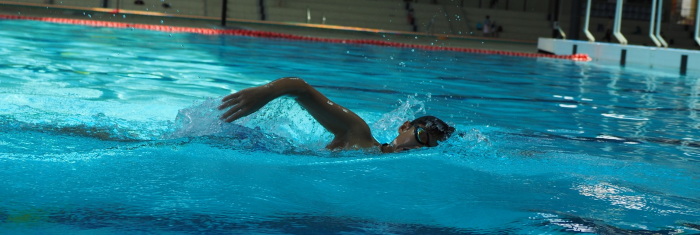
The freestyle stroke is also known as front crawl. Freestyle is the fastest stroke used in competitive swimming and is also widely used for recreational swimming. It is characterized by alternating arm movements accompanied by a flutter kick.
The freestyle stroke is a versatile stroke that allows swimmers to swim with great speed and efficiency. It emphasizes proper body positioning, from keeping the hips high to focusing on an even, long stroke. Freestyle swimming can be used for lakes, rivers, and pools, providing swimmers with a diverse way to get in a great workout. To develop freestyle skills even further, swimmers can practice drills to increase their power, speed, and technique. Drills commonly used for freestyle are catch-up drills, single arm drills, kick drills, and sprint work. Through practice and dedication, swimmers can develop their freestyle stroke to help them swim faster and more confidently in their next swimming adventure.
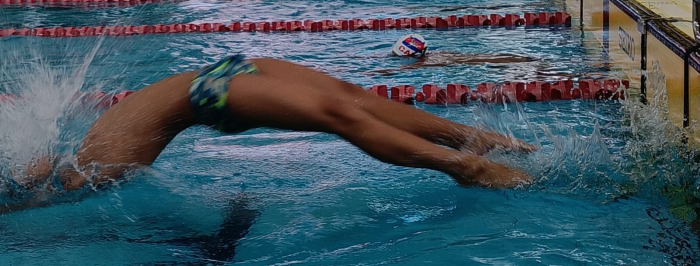 Backstroke is a relatively fast swimming stroke used for both competitive and recreational swimming. It is characterized by a strong reverse flutter kick and arms that move in a continuous circular pattern, alternating from side to side.
Backstroke is a relatively fast swimming stroke used for both competitive and recreational swimming. It is characterized by a strong reverse flutter kick and arms that move in a continuous circular pattern, alternating from side to side.
Backstroke is an easy and relaxing swimming stroke that can help swimmers stay afloat with minimal effort. It is often used in tandem with other swimming strokes to help conserve energy for a longer swim. Unlike freestyle, which requires swimmers to turn their heads to breathe, backstroke allows swimmers to breathe easily throughout the stroke.
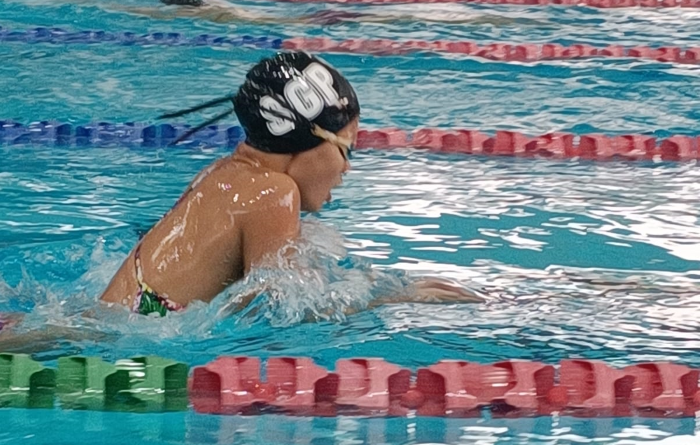
Breaststroke is the slowest of the competitive swimming strokes and is considered to be the most difficult to master. It is characterized by breaststroke kick and arms that move in a circular pattern. It is popular with people who like to swim for fitness as the breathing is much easier than with the front crawl.
Breaststroke requires a lot of coordination between the arms and legs to be executed correctly. The arms sweep outward from the center of the body and then pull back in with the palms facing inwards and the hands passing below and alongside the waist. The legs move in a simultaneous dorsiflexion and flexion pattern. To generate propulsion, the legs and arms should move in a circular pattern, with the arms pushing forward during the up-kick and the legs during the down-kick. The kick should be done underwater with the knees bent and heels drawn up towards the buttocks. For an efficient breaststroke swimmer, the body needs to stay in a horizontal position, with the head and chin in the water, the body undulating like a wave and the toes pointed throughout the stroke.
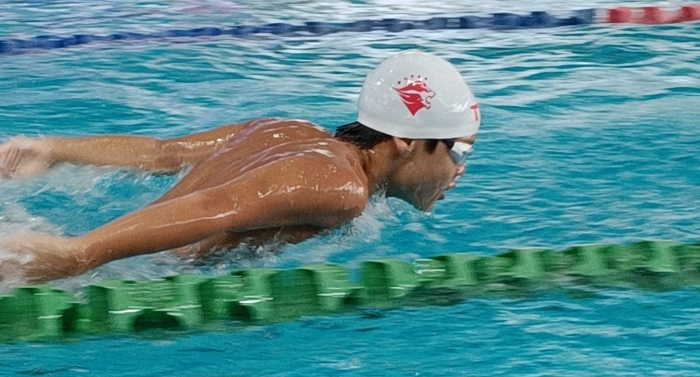
Butterfly is an advanced form of the freestyle stroke that is characterized by an undulating dolphin kick and simultaneous pulling and pushing with both arms.
The wave-like movement of the body serves as the foundation for a good butterfly style. It begins in the trunk and continues through the hips and legs. There are four phases in the butterfly arms pull.
Introductory phase: Utilizing the extended arms at shoulder width, the pulling phase is initiated close to the water surface. The first leg kick begins, and hands then pull outward in a V-like motion to initiate the "high elbow" position. Hands are then moved up to shoulder level, maintaining the "high elbow" position.
Main phase: Propulsive phase
Pushing phase- “keyhole”
Power-“final push-off”
Transition phase: Arms move above water surface.
During this phase, both arms simultaneously breach the water surface, accompanied by a second leg kick. The hands and forearms exit the water first, and the hands maintain their position without any rotation.
Preparatory phase: Arms swing forward (relaxation of the muscles)
In the preparatory phase, the arms should be swung forward in a relaxed manner. The arms should be swung outward with the elbows slightly bent and the shoulders should be slightly raised.
The butterfly stroke is challenging to master as it requires strong core and upper body strength as well as considerable coordination and balance.
When executed properly, the butterfly can be one of the fastest swimming strokes and a great way to work the entire body.
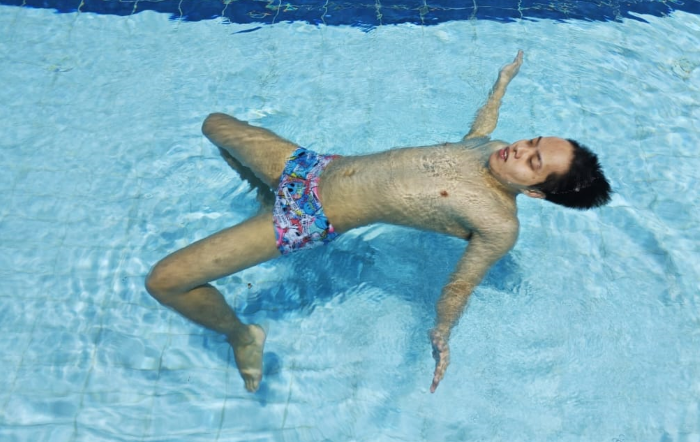 The survival backstroke is a great stroke for beginners to learn. It is a slow, relaxed stroke. The swimmer begins by lying face up in the water with their arms extended in front of the body. The arms should be slightly bent at the elbows and the hands should be cupped, with thumbs pointing outwards. The leg action is a reverse breaststroke kick. As the legs move, the arms should sweep back and forth.
The survival backstroke is a great stroke for beginners to learn. It is a slow, relaxed stroke. The swimmer begins by lying face up in the water with their arms extended in front of the body. The arms should be slightly bent at the elbows and the hands should be cupped, with thumbs pointing outwards. The leg action is a reverse breaststroke kick. As the legs move, the arms should sweep back and forth.
The key difference between backstroke and survival backstroke is the arm action. In backstroke, the arms alternate pulling and pushing the water, whereas in survival backstroke both arms move together in a circular motion.
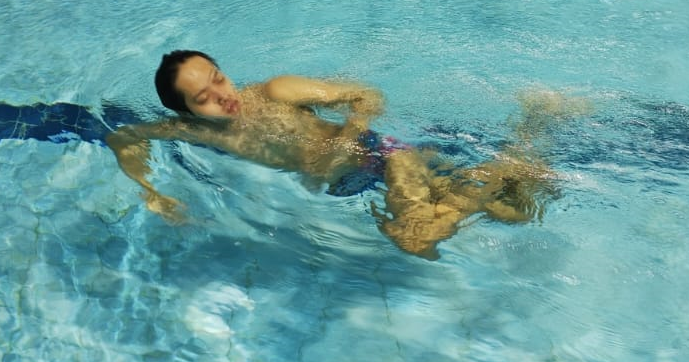
Sidestroke is a swimming stroke that is mainly used for personal survival and lifesaving tow. It is characterized by a scissor kick and double arm movements.
Sidestroke is a relaxed stroke, and is considered a good form of exercise for swimmers looking for low-impact exercise. It also provides a great way for all swimmers to strengthen their core muscles, improve their balance and increase their overall flexibility. It can help to strengthen the back, shoulders, and arms, as well as build endurance.
By practicing all six swimming strokes, swimmers can develop a well-rounded set of skills, increase their endurance and agility, and have fun in the process. Swimming is a great way to get a full-body workout, as it uses all four limbs as well as the core muscles. Swimming can be used as a form of relaxation and stress relief, and is a great way to be social and meet new people.
The benefits of swimming are endless; and the benefits extend beyond the pool environment. Being able to swim from a young age is very important, as it’s an essential life skill every person should have. Water can be dangerous. All activities in the water expose a risk of drowning, and children are more susceptible to it. Hence, a child who learns to swim when young develop a crucial lifelong water awareness and swimming ability.
Learning how to swim can be at any age but learning at an early age is always much faster and easier. As young children’s brains and physical growth are still developing, their ability to grasp more knowledge and skill learning is quicker than when they get older.
Swimming is one of the most popular extra-curricular activities or enrichment programs children usually enjoy and look forward to participating. Going to swimming lessons or joining a local swim club is an excellent way for children to learn water safety and get physical exercise, which provides a workout for the whole body. Swimming is fun and learning to swim early will reduce a child’s fear of water. When they overcome these fears, kids benefit from developing confidence in their swimming ability and will feel more comfortable and enjoy themselves in the water; making pools and beaches a less stressful environment, reduce risk of drowning.
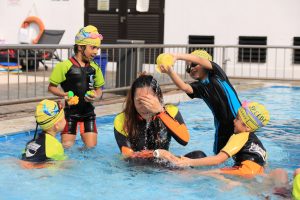
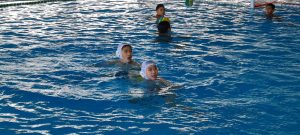
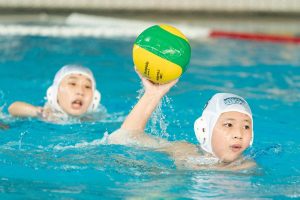
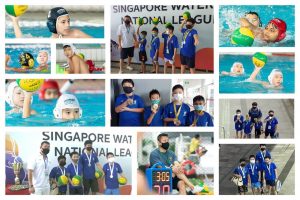
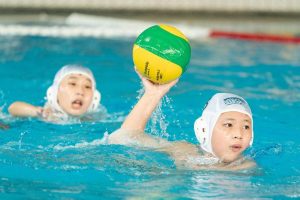

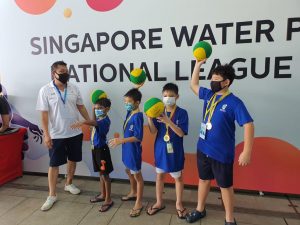
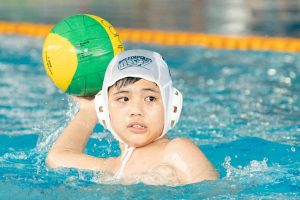
Singapore Swimming Association conducted Singapore Water Polo National League 13U and 11U in March 2021 this year. The competition was conducted in Tampinies Hub, Multipurpose Pool
Our Speediswim Water polo Boys took part in the competition in both U11 and U13 category, the boys did stupendously exceptionally well under the guidance from Coach Hong Boon. The U11 boys won the Gold Medal and Silver for Under 13 boys.
What the boys have displayed with this achievement has not ony improved their Water Polo Skills, but also great team work, humanity and most importantly hard work, discipline and respect. Kudos to Coach Hong Boon in guiding the bos to such a great achievement !! Lets keep working hard and bringing laurels !!